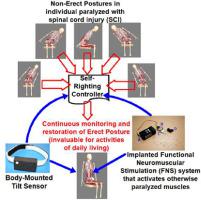Medical Engineering & Physics ( IF 1.7 ) Pub Date : 2020-10-15 , DOI: 10.1016/j.medengphy.2020.10.010 Akhil Bheemreddy 1 , Lisa M Lombardo 2 , Michael E Miller 2 , Kevin M Foglyano 2 , Stephanie Nogan-Bailey 2 , Ronald J Triolo 3 , Musa L Audu 4

|
Spinal cord injury (SCI) often results in loss of the ability to keep the trunk erect and stable while seated. Functional neuromuscular stimulation (FNS) can cause muscles paralyzed by SCI to contract and assist with trunk stability. We have extended the results of a previously reported threshold-based controller for restoring upright posture using FNS in the sagittal plane to more challenging displacements of the trunk in the coronal plane. The system was applied to five individuals with mid-thoracic or higher SCI, and in all cases the control system successfully restored upright sitting. The potential of the control system to maintain posture in forward-sideways (diagonal) directions was also tested in three of the subjects. In all cases, the controller successfully restored posture to erect. Clinically, these results imply that a simple, threshold based control scheme can restore upright sitting from forward, lateral or diagonal leaning without a chest strap; and that removal of barriers to upper extremity interaction with the surrounding environment could potentially allow objects to be more readily retrieved from around the wheelchair. Technical performance of the system was assessed in terms of three variables: response time, recovery time and percent maximum deviation from erect. Overall response and recovery times varied widely among subjects in the coronal plane (415±213 ms and 1381±883 ms, respectively) and in the diagonal planes (530±230 ms and 1800±820 ms, respectively). Average response time was significantly lower (p < 0.05) than the recovery time in all cases. The percent maximum deviation from erect was of the order of 40% or less for 9 out of 10 cases in the coronal plane and 5 out of 6 cases in diagonal directions.
中文翻译:

一种闭环自扶正控制器,用于脊髓损伤后冠状面和对角面的坐姿平衡
脊髓损伤 (SCI) 经常导致坐下时失去保持躯干直立和稳定的能力。功能性神经肌肉刺激 (FNS) 可导致因 SCI 麻痹的肌肉收缩并协助躯干稳定。我们已将先前报道的基于阈值的控制器的结果扩展为使用 FNS 在矢状平面中恢复直立姿势,以应对冠状平面中更具挑战性的躯干位移。该系统应用于五名胸中段或更高位 SCI 患者,在所有情况下,控制系统均成功恢复了直立坐姿。还在三名受试者中测试了控制系统保持前向(对角线)方向姿势的潜力。在所有情况下,控制器都成功地恢复了直立姿势。在临床上,这些结果意味着一个简单的、基于阈值的控制方案可以在没有胸带的情况下从前倾、侧倾或斜倚恢复直立坐姿;并且消除上肢与周围环境相互作用的障碍可能会使物体更容易从轮椅周围取回。系统的技术性能根据三个变量进行评估:响应时间、恢复时间和与竖立的最大偏差百分比。冠状面(分别为 415±213 毫秒和 1381±883 毫秒)和对角面(分别为 530±230 毫秒和 1800±820 毫秒)的受试者的总体反应和恢复时间差异很大。平均响应时间显着缩短(并且消除上肢与周围环境相互作用的障碍可能会使物体更容易从轮椅周围取回。系统的技术性能根据三个变量进行评估:响应时间、恢复时间和与竖立的最大偏差百分比。冠状面(分别为 415±213 毫秒和 1381±883 毫秒)和对角面(分别为 530±230 毫秒和 1800±820 毫秒)的受试者的总体反应和恢复时间差异很大。平均响应时间显着缩短(并且消除上肢与周围环境相互作用的障碍可能会使物体更容易从轮椅周围取回。系统的技术性能根据三个变量进行评估:响应时间、恢复时间和与竖立的最大偏差百分比。冠状面(分别为 415±213 毫秒和 1381±883 毫秒)和对角面(分别为 530±230 毫秒和 1800±820 毫秒)的受试者的总体反应和恢复时间差异很大。平均响应时间显着缩短(恢复时间和从直立的最大偏差百分比。冠状面(分别为 415±213 毫秒和 1381±883 毫秒)和对角面(分别为 530±230 毫秒和 1800±820 毫秒)的受试者的总体反应和恢复时间差异很大。平均响应时间显着缩短(恢复时间和从直立的最大偏差百分比。冠状面(分别为 415±213 毫秒和 1381±883 毫秒)和对角面(分别为 530±230 毫秒和 1800±820 毫秒)的受试者的总体反应和恢复时间差异很大。平均响应时间显着缩短(p < 0.05) 比所有情况下的恢复时间。冠状面 10 例中有 9 例和对角线方向 6 例中有 5 例与直立的最大偏差百分比约为 40% 或更少。










































 京公网安备 11010802027423号
京公网安备 11010802027423号